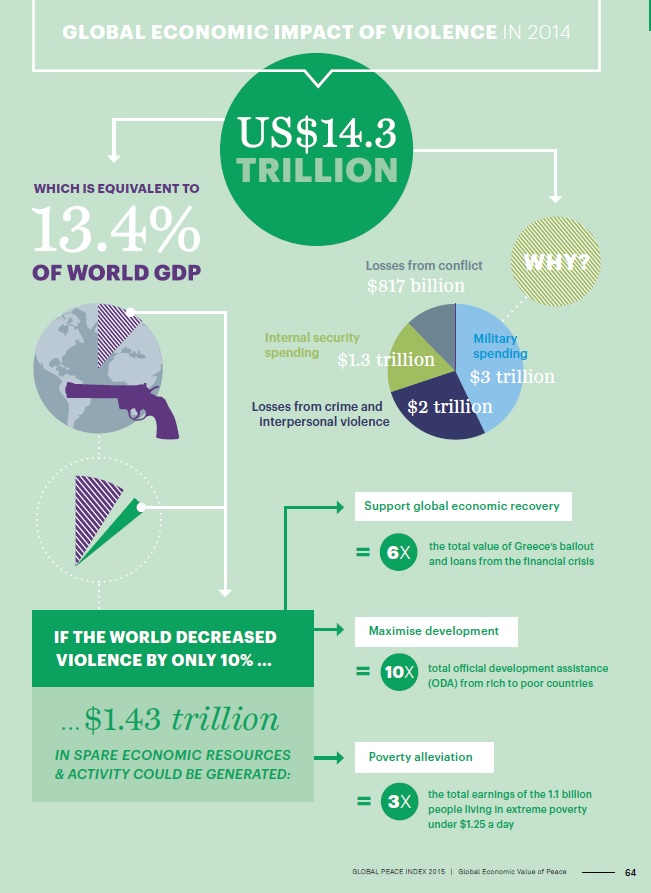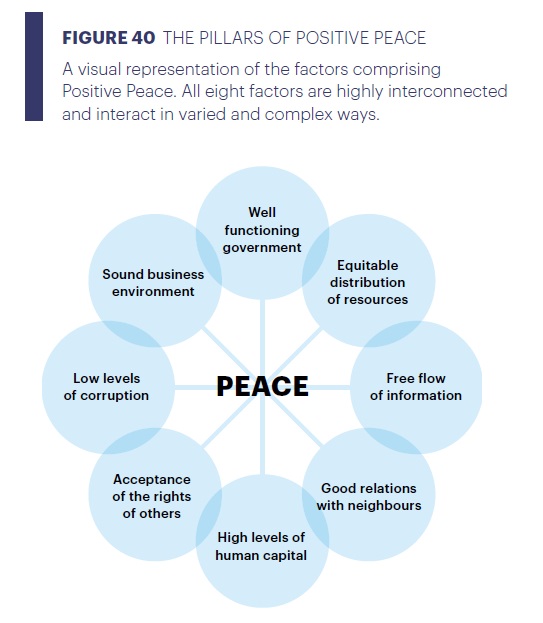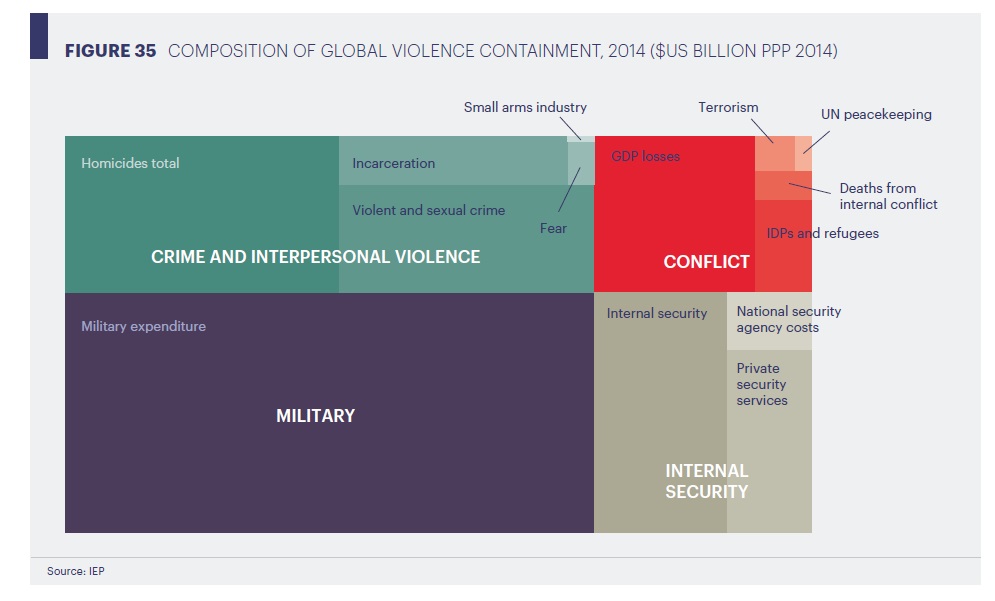
For the past 8 years, the Global Peace Index (GPI) has been prepared by ‘think tank’ the Institute for Economics and Peace (HQ Sydney with branches in New York and Mexico) focused on the measurement of peace, its causes and its economic value. The Index ranks countries according to their level of peacefulness using 23 qualitative and quantitative indicators for some 162 independent states, covering 99.6 per cent of the world’s population. The index measures peace using three broad themes – the level of safety and security in society, the extent of domestic and international conflict and the degree of militarisation.
>> see the annotation of the 2015 Global Peace Index.
Selected key points from the 2015 Global Peace index:

1. Over the past 8 years, there has been a 2.4% decline in the average country score for peacefulness driven largely by internal factors – of the 5 key indicators which deteriorated by >5%, 4 are internal and 1 external: refugees and IDPs as a percentage of the population, deaths from internal conflict, the impact of terrorism, the likelihood of violent demonstrations and perceptions of criminality.
2. The latest UN High Commission for Refugees estimates indicate that more than 50 million are now either refugees or internally displaced because of conflict and violence – the highest number since the end of the Second World War. A third of people displaced by conflict inside their own countries in 2014 are in Iraq and Syria alone.
3. Violent acts described as ‘Terrorism’ (the term is hotly contested) have grown steadily over the last decade with a 61% increase in 2013 resulting in almost 18,000 deaths. Of those deaths, 82% occurred in just 5 countries: Iraq, Afghanistan, Pakistan, Nigeria and Syria (attacks have also occurred in countries such as France, Denmark and Australia).
4. On the ‘good news’ front, some peace indicators have improved – relations with neighbouring countries has grown stronger, particularly in South America, financial contributions to UN peacekeeping funding has increased and the number and intensity of external conflicts has fallen as many countries have wound down their military involvement in Iraq and Afghanistan.
5. The economic impact of violence on the global economy in 2014 was substantial, estimated at US$14.3 trillion or 13.4% of world GDP. This is equal to the combined economies of Brazil, Canada, France, Germany, Spain and the UK. Since 2008, the total economic impact on global GDP has increased by 15.3%, from US$12.4 trillion to US$14.3 trillion.
6. In 2014, 81 countries became more peaceful and 78 less so. The MENA region (Middle East North Africa) currently ranks as the most violent region, overtaking South Asia (which includes Afghanistan). The most peaceful region is Europe while Latin America remained the world’s most violent region in terms of societal safety and security; this is particularly the case for Central America and the Caribbean, the lowest ranked region and where many of the world’s highest homicide rates can be found.
7. Iceland, Denmark, Austria, New Zealand and Switzerland were the most peaceful countries (Ireland ranks 12th and the UK 39th) while Syria, Iraq, Afghanistan, South Sudan and the Central African Republic were the world’s least peaceful countries. Countries with significant improvements included Guinea Bissau, Cote d’Ivoire, Egypt, Benin and Tajikistan while significant deterioration was recorded in Libya, Ukraine, Djibouti, Niger and South Sudan. Over two billion people live in the 20 least peaceful countries in the world, compared to less than 500 million in the 20 most peaceful.

8. The 3 most costly components (direct and indirect costs) of ‘containing violence’ are the global military expenditure (43%), crime and interpersonal violence (homicide – 14%) and internal security (police – 11%). UN peacekeeping is one of the smallest, at only 0.17% of total violence containment costs.
9. Violence costs society dearly through disruptions in consumption, investment, trade and production; it diverts investment from productive areas such as business, education, infrastructure and health into areas of violence containment such as large security forces, high prison populations or the military. The report measures ‘positive peace’ through the Positive Peace Index (PPI) using 8 categories, each with 3 specific indicators. The categories are a sound business environment, high levels of human capital, low levels of corruption, free flow of information, good relations with neighbours, acceptance of the rights of others, well-functioning government and equitable distribution of resources.
10. The violence containment costs for Ireland in 2014 were US$7,750 million (PPP) amounting to US$1,687 per person or 3% of GDP.
The report also includes analytical sections on the Middle East, Societal Safety and Security, Militarisation and case studies of 5 post-conflict countries (Rwanda, Georgia, Myanmar, Indonesia and Cote d’Ivoire).
